 |
|
Популярные авторы:: Грин Александр :: Раззаков Федор :: Толстой Лев Николаевич :: Борхес Хорхе Луис :: Горький Максим :: Херберт Фрэнк :: Лондон Джек :: Азимов Айзек :: Чехов Антон Павлович :: Громов Дмитрий Популярные книги:: Дюна (Книги 1-3) :: Справочник по реестру Windows XP :: The Boarding House :: Хозяин Вороньего мыса (Том 1) :: Приключения Томека на Черном континенте :: Танец Арлекина :: Бандит с Черных Гор :: Техника спортивной езды :: РОМАН НАОБОРОТ (женский взгляд на случайную связь) :: Генерация высококачественного кода для программ, написанных на СИ |
11 сентября 2001ModernLib.Net / Публицистика / Мейссан Тьерри / 11 сентября 2001 - Чтение (стр. 16)
The viability of a 3-5 trillion Btu/hr (1-1.15 GW) fire depends on the fuel and air supply. The surface area of office contents needed to support such a fire ranges from about 30,000-50,000 square feet, depending on the composition and final arrangement of the contents and the fuel loading present. Given the typical occupied area of a floor as approximately 30,000 square feet, it can be seen that simultaneous fire involvement of an area equal to 1-2 entire floors can produce such a fire. Fuel loads are typically described in terms of the equivalent weight of wood. Fuel loads in office-type occupancies typically range from about 4-12 psf, with the mean slightly less than 8 psf (Culver 1977). File rooms, libraries, and similar concentrations of paper materials have significantly higher concentrations of fuel. At the burning rate necessary to yield these fires, a fuel load of about 5 psf would be required to provide sufficient fuel to maintain the fire at full force for an hour, and twice that quantity to maintain it for 2 hours. The air needed to support combustion would be on the order of 600,000-1,000,000 cubic feet per minute. Air supply to support the fires was primarily provided by openings in the exterior walls that were created by the aircraft impacts and fireballs, as well as by additional window breakage from the ensuing heat of the fires. Table 2.1 lists the estimated exterior wall openings used in these calculations. Although the table shows the openings on a floor-by-floor basis, several of the openings, particularly in the area of impact, actually spanned several floors (see Figure 2-17). Sometimes, interior shafts in burning high-rise buildings also deliver significant quantities of air to a fire, through a phenomenon known as «stack effect,» which is created when differences between the ambient exterior air temperatures and the air temperatures inside the building result in differential air pressures, drawing air up through the shafts to the fire area. Because outside and inside temperatures appear to have been virtually the same on September 11, this stack effect was not expected to be strong in this case. Based on photographic evidence, the fire burned as a distributed collection of large but separate fires with significant temperature variations from space to space, depending on the type and arrangement of combustible material present and the available air for combustion in each particular space. Consequently, the temperature and related incident heat flux to the structural elements varied with both time and location. This information is not currently available, but could be modeled with advanced CFD fire models. Damage caused by the aircraft impacts is believed to have disrupted the sprinkler and fire standpipe systems, preventing effective operation of either the manual or automatic suppression systems. Even if these systems had not been compromised by the impacts, they would likely have been ineffective. It is believed that the initial flash fires of jet fuel would have opened so many sprinkler heads that the systems would have quickly depressurized and been unable to effectively deliver water to the large area of fire involvement (this is garbage, or a significant design fault). Further, the initial spread of fires was so extensive as to make occupant use of small hose streams ineffective. 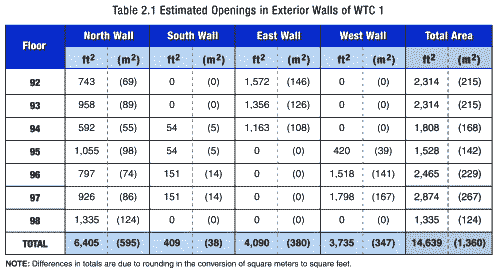 Table 2.1 Estimated Openings in Exterior Walls of WTC 1 Some occupants of WTC 1 and WTC 2 began to voluntarily evacuate the buildings soon after the first aircraft struck WTC 1. Full evacuation of all occupants below the impact floors in WTC 1 was ordered soon after the second plane hit the south tower (Smith 2002). As indicated by Cauchon (2001a), the overall evacuation of the towers was as much of a success as thought possible, given the overall incident. Cauchon indicates that, between both towers, 99 percent of the people below the floors of impact survived (2001a) and by the time WTC 2 collapsed, the stairways in WTC 1 were observed to be virtually clear of building occupants (Smith 2002). In part this was possible because conditions in the stairways below the impact levels largely remained tenable. However, this may also be a result of physical changes and training programs put into place following the 1993 WTC bombing. Important modifications to building egress made following the 1993 WTC bombing included the placement of photo-luminescent paint on the egress paths to assist in wayfinding (particularly at the stair transfer corridors) and provision of emergency lighting for the stairways. In addition, an evacuation training program was instituted (Masetti 2001). Shortly before the times of collapse, the stairways were reported as being relatively clear, indicating that occupants who were physically capable and had access to egress routes were able to evacuate from the buildings (Mayblum 2001). People within and above the impact area could not evacuate, simply because the stairways in the impact area had been destroyed. Some survivors reported that, at about the same time that WTC 2 collapsed, lighting in the stairways of WTC 1 was lost (Mayblum 2001). Also, there were several accounts of water flowing down the stairways and of stairwells becoming slippery beginning at the 10th floor (Labriola 2001). Anecdotes indicate altruistic behavior was commonly displayed. Some mobility-impaired occupants were carried down many flights of stairs by other occupants. There were also reports of people frequently stepping aside and temporarily stopping their evacuation to let burned and badly injured occupants pass by (Dateline NBC 2001, Hearst 2001). Occupants evacuating from the 91st floor noted that, as they descended to lower levels of the building, traffic was considerably impaired and formed into a slowly moving single-file progression, as evacuees worked their way around firefighters and other emergency responders, who were working their way up the stairways or who were resting from the exertion of the climb (Shark and McIntyre 2001). As previously indicated, the impact of the aircraft into WTC 1 substantially degraded the strength of the structure to withstand additional loading and also made the building more susceptible to fire-induced failure. Among the most significant factors: • The force of the impact and the resulting debris field and fireballs probably compromised spray applied fire protection of some steel members in the immediate area of impact. The exact extent of this damage will probably never be known, but this likely resulted in greater susceptibility of the structure to fire-related failure. • Some of the columns were under elevated states of stress following the impact, due to the transfer of load from the destroyed and damaged elements. • Some portions of floor framing directly beneath the partially collapsed areas were carrying substantial additional weight from the resulting debris and, in some cases, were likely carrying greater loads than they were designed to resist (this is probably not true). As fire spread and raised the temperature of structural members, the structure was further stressed and weakened, until it eventually was unable to support its immense weight. Although the specific chain of events that led to the eventual collapse will probably never be identified (so they hope) the following effects of fire on structures may each have contributed to the collapse in some way. Appendix A presents a more detailed discussion of the structural effects of fire. • As floor framing and supported slabs above and in a fire area are heated, they expand. The people who designed the towers were not fools and knew all this. They designed the towers to survive much more serious fires than those that occurred on September 11. As a structure expands, it can develop additional, potentially large, stresses in some elements. If the resulting stress state exceeds the capacity of some members or their connections, this can initiate a series of failures (Figure 2-20). 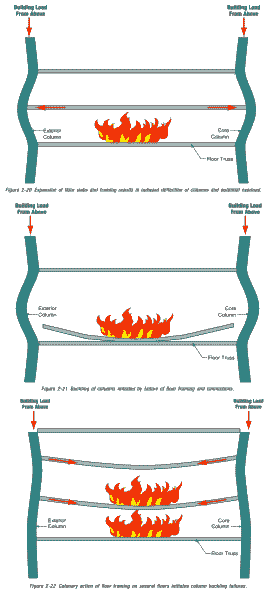 • As the temperature of floor slabs and support framing increases, these elements can lose rigidity and sag into catenary action. As catenary action progresses, horizontal framing elements and floor slabs become tensile elements, which can cause failure of end connections (Figure 2-21) and allow supported floors to collapse onto the floors below. The presence of large amounts of debris on some floors of WTC 1 would have made them even more susceptible to this behavior. In addition to overloading the floors below, and potentially resulting in a pancake-type collapse of successive floors, local floor collapse would also immediately increase the laterally unsupported length of columns, permitting buckling to begin. As indicated in Appendix B, the propensity of exterior columns to buckle would have been governed by the relatively weak bolted column splices between the vertically stacked prefabricated exterior wall units. This effect would be even more likely to occur in a fire that involves several adjacent floor levels simultaneously, because the columns could effectively lose lateral support over several stories (Figure 2-22). • As the temperature of column steel increases, the yield strength and modulus of elasticity degrade and the critical buckling strength of the columns will decrease, potentially initiating buckling, even if lateral support is maintained. This effect is most likely to have been significant in the failure of the interior core columns. To believe the silly little tale you are being told here, you must believe that the designers were fools and did not follow the law and design a building that could resist a serious multi-floor office fire. Note, that if the above scenario is correct then the towers would collapse in the event of any such fire. The aircraft impact plays no significant role in the sad little tale told here, only the fire. The fact that the towers collapsed in 8-10 seconds (essentially free-fall) is massive evidence that they were deliberately demolished. The fact that they fell at such a rate means that they did not encounter any resistance from the supposedly undamaged parts of the structure. That is, no resistance was encountered from any of the immensely strong parts of the structure that held the building up in the first place. From this one can conclude that the lower «undamaged» parts were actually very damaged (probably by a multitude of small explosive charges as in a controlled demolition). Construction of WTC 1 resulted in the storage of more than 4 x 10^11 joules of potential energy over the 1,368-foot height of the structure. Of this, approximately 8 x 10^9 joules of potential energy were stored in the upper part of the structure, above the impact floors, relative to the lowest point of impact. Once collapse initiated, much of this potential energy was rapidly converted into kinetic energy. As the large mass of the collapsing floors above accelerated and impacted on the floors below, it caused an immediate progressive series of floor failures, punching each in turn onto the floor below, accelerating as the sequence progressed. This is saying that the WTC towers were designed and built like a house of cards. Real buildings do not exhibit this type of behavior (if they did the designers and/or builders would be hung). As the floors collapsed, this left tall freestanding portions of the exterior wall and possibly central core columns. As the unsupported height of these freestanding exterior wall elements increased, they buckled at the bolted column splice connections, and also collapsed. Perimeter walls of the building seem to have peeled off and fallen directly away from the building face, while portions of the core fell in a somewhat random manner. The perimeter walls broke apart at the bolted connections, allowing individual prefabricated units that formed the wall or, in some cases, large assemblies of these units to fall to the street and onto neighboring buildings below. Review of videotape recordings of the collapse taken from various angles indicates that the transmission tower on top of the structure began to move downward and laterally slightly before movement was evident at the exterior wall. This suggests that collapse began with one or more failures in the central core area of the building. This is probably correct, after all the central core area is where the explosives would have been set. This is consistent with the observations of debris patterns from the 91st floor, previously discussed. This is also supported by preliminary evaluation of the load carrying capacity of these columns, discussed in more detail in Section 2.2.2.2. The core columns were not designed to resist wind loads and, therefore, had less reserve capacity than perimeter columns. As some exterior and core columns were damaged by the aircraft impact, the outrigger trusses at the top of the building shifted additional loads to the remaining core columns, further eroding the available factor of safety. This would have been particularly significant in the upper portion of the damaged building. In this region, the original design load for the core columns was less than at lower floors, and the column sections were relatively light. The increased stresses caused by the aircraft impact could easily have brought several of these columns close to their ultimate capacity, so that relatively little additional effects due to fire would have been required to initiate the collapse. Once movement began, the entire portion of the building above the area of impact fell in a unit, pushing a cushion of air below it. As this cushion of air pushed through the impact area, the fires were fed by new oxygen and pushed outward, creating the illusion (no illusion) of a secondary explosion. 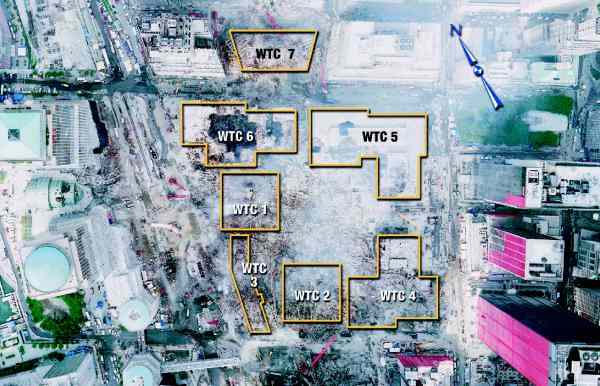 Figure 2-23 Aerial photograph of the WTC site after September 11 attack showing adjacent buildings damaged by debris from the collapse of WTC 1. Although the building appeared to collapse within its own footprint, a review of aerial photographs of the site following the collapse, as well as damage to adjacent structures, suggests that debris impacted the Marriott Hotel (WTC 3), the Customs House (WTC 6), the Morgan Stanley building (WTC 5), WTC 7, and the American Express and Winter Garden buildings located across West Street (Figure 2-23). The debris field extended as far as 400-500 feet from the tower base. United Airlines Flight 175 struck the south face of WTC 2 approximately between the 78th and 84th floors. The zone of impact extended from near the southeast corner of the building across much of the building face (Figures 2-24 and 2-25). The aircraft caused massive damage to the south face of the building in the zone of impact (Figures 2-26 and 2-27). At the central zone of impact corresponding to the airplane fuselage and engines, six of the prefabricated, three-column sections that formed the exterior walls were broken loose from the structure, with some of the elements apparently pushed inside the building envelope. Locally, as was the case in WTC 1, floors supported by these exterior wall sections appear to have partially collapsed. Away from this central zone, in the areas impacted by the outer wing structures, the exterior steel columns  Figure 2-24 Southeast corner of WTC 2 shortly after aircraft impact. 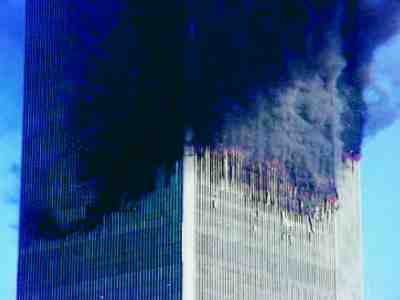 Figure 2-26 Impact damage to the south and east faces of WTC 2. were fractured by the impact. Photographic evidence suggests that from 27 to 32 columns along the south building face were destroyed over a five-story range. Partial collapse of floors in this zone appears to have occurred over a horizontal length of approximately 70 feet, while floors in other portions of the building appeared to remain intact. It is probable that the columns in the southeast corner of the core also experienced some damage because they would have been in the direct travel path of the fuselage and port engine (Figure 2-25).  Figure 2-25 Approximate zone of impact of aircraft on the south face of WTC 2. It is known that debris from the aircraft traveled completely through the structure. For example, a landing gear from the aircraft that impacted WTC 2 was found to have crashed through the roof of a building located six blocks to the north, and one of the jet engines was found at the corner of Murray and Church Streets. The extent to which debris scattered throughout the impact floors is also evidenced by photographs of the fireballs that occurred as the aircraft struck the building (Figure 2-28). Figure 2-29 shows a portion of the fuselage of the aircraft, lying on the roof of WTC 5. 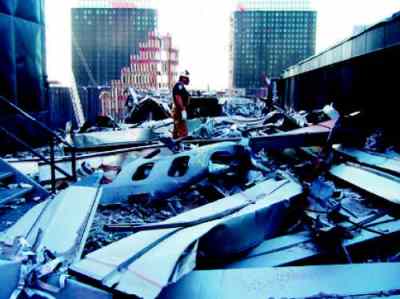 Figure 2-29 A portion of the fuselage of United Airlines Flight 175 on the roof of WTC 5. As described for WTC 1, this debris doubtless caused some level of damage to the structure across the floor plates, including interior framing; core columns at the southeast corner of the core; framing at the north, east, and west walls; and the floor plates themselves. Figure 2-30, showing the eastern side of the north face of the WTC 2 partially hidden behind WTC 1, suggests that damage to the exterior walls was not severe except at the zone of impact. The exact extent of this damage will likely never be known with certainty. It is evident that the structure retained sufficient integrity and strength to remain globally stable for a period of approximately 56 minutes. 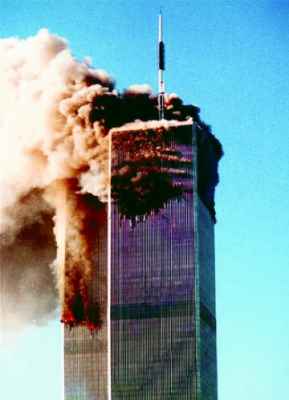 Figure 2-30 North face of WTC 2 opposite the zone of impact on the south face, behind WTC 1. There are some important differences between the impact of the aircraft into WTC 2 and the impact into WTC 1. First, United Airlines Flight 175 was flying much faster, with an estimated speed of 590 mph, while American Airlines Flight 11 was flying at approximately 470 mph. The additional speed would have 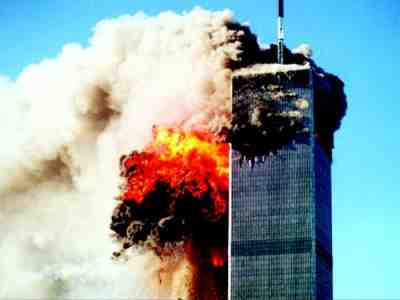 Figure 2-28 Conflagration and debris exiting the north wall of WTC 2, behind WTC 1. given the aircraft a greater ability to destroy portions of the structure. The zone of aircraft impact was skewed toward the southeast corner of WTC 2, while the zone of impact on WTC 1 was approximately centered on the building's north face. The orientation of the core in WTC 2 was such that the aircraft debris would only have to travel 35 feet across the floor before it began to impact and damage elements of the core structure. Finally, the zone of impact in WTC 2 was nearly 20 stories lower than that in WTC 1, so columns in this area were carrying substantially larger loads. It is possible, therefore, that structural damage to WTC 2 was more severe than that to WTC 1, partly explaining why WTC 2 collapsed more quickly than WTC 1. An approximate linear structural analysis of WTC-2 was performed using SAP-2000 software (CSI 2000) to provide an understanding of the likely stress state in the building following the aircraft impact. The upper 55 stories of the building's exterior-wall frame were explicitly modeled using beam and column elements. This encompassed the entire structure above the zone of impact and about 20 stories below. The lower 55 stories of the exterior were modeled as a «boundary condition» consisting of a perimeter super-beam that was 52 inches deep and about 50 inches wide, supported on a series of springs. A base spring was provided at each column location to represent the axial stiffness of the columns from the 55th floor down to grade. The outrigger trusses at the top of the building were explicitly modeled, using truss-type elements. The interior core columns were modeled as spring elements. An initial analysis of the building was conducted to simulate the pre-impact condition. In addition to the weight of the floor itself (approximately 54 psf at the building edges and 58 psf at the building sides), a uniform floor loading of 12 psf was assumed for partitions and an additional 20 psf was conservatively assumed to represent furnishings and contents. At the 80th floor level, exterior columns were found to be approximately uniformly loaded with an average utilization ratio (ratio of actual applied stress to ultimate stress) of under 20 percent. This low utilization ratio is due in part to the unusually close spacing of the columns in this building, which resulted in a very small tributary area for each column. It reflects the fact that wind and deflection considerations were dominant factors in the design. Core columns were more heavily loaded with average calculated utilization ratios of 60 percent, which would be anticipated for these columns, which were designed to resist only gravity loads. 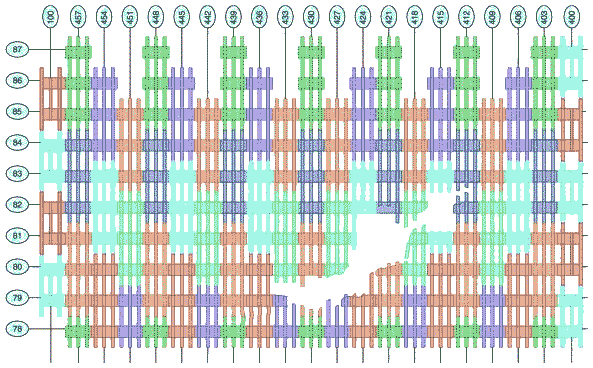 General notes: (1) Column damage captured from photographs and enchanced video. (2) Damage to column lines 413-418 at levels 81 and 82 is estimated. (3) There is not sufficient information to detail damage to column lines 408-411 at levels 83-84. Figure 2-27 Impact damage to exterior columns on thr south face of WTC 2. A second analysis was conducted to estimate the demands on columns immediately following aircraft impact and before fire effects occurred. Exterior columns were removed from the model to match the damage pattern illustrated in Figure 2-27. Although some core columns were probably damaged by the aircraft impact, the exact extent of this damage is not known and therefore was not considered in the model. As a result, this analysis is thought to underestimate the true stress state in the columns immediately after impact. The analysis indicates that most of the loads initially carried by the damaged exterior columns were transferred by Vierendeel truss action to the remaining exterior columns immediately adjacent to the impact area. If the floors at this level are assumed to remain intact and capable of providing lateral support to the columns, this raised the utilization ratio for the most heavily loaded column immediately adjacent to the damage area to approximately a value of 1.0. At a value of 1.0, columns would lose stiffness and shift load to adjacent columns. Based on this analysis, it appears that the structure had significant remaining margin against collapse. However, this analysis does not consider damage to the building core, which was likely significant. Columns located further from the damage area are less severely impacted, and columns located only 20 feet away from the damaged area experience almost no increase in demand at all. These data are plotted in Figure 2-31. 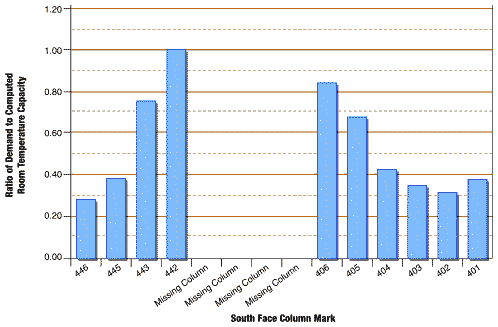 Figure 2-31 Plot of column utilization ratio at the 80th floor of WTC 2, viewed looking outward. (Conservatively assumes columns 401-411 and 440-441 to be missing.) The columns immediately above the damage area are predicted to act as tension members, transferring approximately 10 percent of the load initially carried by the damaged columns upward to the outrigger trusses, which, in turn, transfer this load back to the core columns. Not considering any damage to the core columns, utilization ratios on these elements are predicted to increase by about 20 percent at the 80th floor level. In upper stories, where the core columns were more lightly loaded, the increase in utilization ratio is substantially larger and may have approached a value of 1.0. These conditions would have been made more severe by damage to one or more core columns. Following the impact, fires spread throughout WTC 2, similar to the manner previously described for WTC 1. Extensive videotape of the fires' development through the building was recorded from various exterior vantage points. This videotape suggests that, in the minutes immediately preceding the collapse, the most intensive fires occurred along the north face of the building, near the 80th floor level. Just prior to the collapse, a stream of molten material—possibly aluminum from the airliner—was seen streaming out of a window opening at the northeast corner at approximately this level. This is of particular interest because, although the building collapse appears to have initiated at this floor level, the initiation seems to have occurred at the southeast rather than the northeast corner. Although less time was available for evacuation of WTC 2 than for WTC 1, and the aircraft hit the building some 16 floors lower than in WTC 1, fewer casualties occurred within this building. The reduced number of casualties to building occupants in WTC 2 may be attributed to the movement of some of the building occupants immediately after the aircraft impact into WTC 1 and before the second aircraft struck WTC 2. Several survivors from WTC 2 stated that, following the impact of the aircraft into WTC 1, a message was broadcast over the loudspeaker system indicating that WTC 2 was secure and that occupants should return to their offices (Scripps 2001, BBC News 2001). Many of these survivors did not heed the announcement and continued to exit the building, using the elevators. Survivors also related reports of individuals who listened to the message, returned to their floors, and did not make it out after the second aircraft impacted WTC 2. Some survivors related that a small number of people traveled to the roof under the assumption that a helicopter rescue was possible (Cauchon 2001b). The same types of structural behaviors and failure mechanisms previously discussed are equally likely to have occurred in WTC 2, resulting in the initiation of progressive collapse, approximately 56 minutes after the aircraft impact. Review of video footage of the WTC 2 collapse suggests that it probably initiated with a partial collapse of the floor in the southeast corner of the building at approximately the 80th level. This appears to have been followed rapidly by collapse of the entire floor level along the east side, as evidenced by a line of dust blowing out of the side of the building. As this floor collapse occurred, columns along the east face of the building appear to buckle in the region of the collapsed floor, beginning at the south side and progressing to the north, causing the top of the building to rotate toward the east and south and to begin to collapse downward (Figure 2-32). It should be noted that failure of core columns in the southeast corner of the building could have preceded and triggered these events. As in WTC 1, a very large quantity of potential energy was stored in the building, during its construction. Once collapse initiated, much of this energy was rapidly released and converted into kinetic energy, in the form of the rapidly accelerating mass of the structure above the aircraft impact zone. The impact of this rapidly moving mass on the lower structure caused a wide range of structural failures in the floors directly at and below the aircraft impact zone, in turn causing failure of these floors. As additional floor plates failed, the mass associated with each of these floors joined that of the tower above the impact area, increasing the destructive energy on the floors immediately below. This initiated a chain of progressive failures that resulted in the total collapse of the building. A review of aerial photographs of the site, following the collapse, as well as identification of pieces of structural steel from WTC 2, strongly suggests that while the top portion of the tower fell to the south and east, striking Liberty Street and the Bankers Trust building, the lower portion of the tower fell to the north and west, striking the Marriott Hotel (WTC 3). Again, the debris pattern spread laterally as far as approximately 400-500 feet from the base of the structure. As first WTC 2, then WTC 1 collapsed, nearly 600,000 tons of debris fell onto the Plaza level, punching large holes through the Plaza and the six levels of substructure below, and partially filling the substructure with debris. This damage severely compromised the ability of the slabs to provide lateral bracing of the substructure walls against the induced lateral earth pressures from the unexcavated side. This condition was most severe at the southern side of the substructure, adjacent to WTC 2 and WTC 3. In this region, debris from the collapsed WTC 2 punched through several levels of substructure slab, but did not completely fill the void left behind, leaving the south wall of the substructure in an unbraced condition over a portion of its length. In early October, large cracks were observed along Liberty Street, indicating that the south wall had started to move into the failed area under the influence of the lateral earth pressures. Mueser-Rutledge Engineers were retained to review the situation and make suitable recommendations. 1, 2, 3, 4, 5, 6, 7, 8, 9, 10, 11, 12, 13, 14, 15, 16, 17, 18, 19 |
|||||||